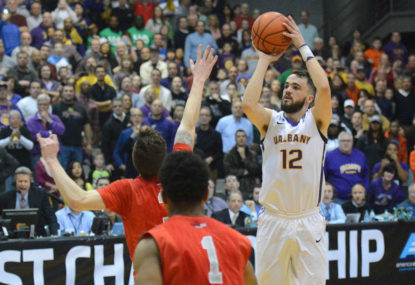College basketball is struggling. Attendance has dropped each of the past seven years, as have television ratings, with ESPN’s current average down 6 per cent from last season.
Scoring is at an all-time low and the rough, physical play is reminiscent of the NBA in a bygone era.
A 35-second shot clock, control-freak coaches who micro-manage every possession, pampered, underskilled kids from AAU programs and ‘one and done’ stars putting in a year on campus before entering the NBA draft are changing the game, and it’s not for the better.
Even its ardent supporters are critical. ESPN analyst Jay Bilas, a former Duke star, calls the current college game “unwatchable”.
But starting this week all of that will be forgotten, as fans and the media focus on the NCAA men’s basketball tournament, an FA Cup-style knockout competition also known as ‘March Madness’ or ‘The Big Dance’.
Not only does March Madness inspire millions of Americans to fill out ‘brackets’ and gamble billions of dollars (pseudo-illegally), it’s one of US sports’ biggest and best annual events and rarely fails to disappoint in terms of emotional storylines.
You want tears? In 1990, Loyola Marymount went on an amazing run, knocking off three higher-rated opponents following the sudden death of their best player, Hank Gathers, who collapsed and died on the court during their conference tournament.
You want David vs Goliath? In 1985, #8 seed Villanova stunned Patrick Ewing and powerful Georgetown 66-64. Villanova is still the lowest seed to win the championship.
Already the 2015 tournament has thrown up some unbelievable feel-good stories, with Australian Peter Hooley taking centre stage after hitting the game-winning three-point shot for the University of Albany.
Hooley, a guard from Adelaide, had recently rejoined the team after flying home to be with his mother, who passed away from cancer six weeks ago. With Albany down by two points, Hooley gathered a rebound and let a shot fly. It ripped the net and the Great Danes punched their ticket to the tournament.
An emotional Hooley was mobbed by teammates and fans, as the ESPN announcers re-told his remarkable personal tale.
And that’s the thing about college hoops.
It’s not the prettiest basketball, and it’s light years away from the NBA – which has been rejuvenated by young stars like Stephen Curry – but there is no shortage of amazing stories that continue to emerge year after year.
This year you have Kentucky, full of high school All Americans and coached in a pro style by John Calipari. The Wildcats are 34-0 and are hoping to become the first team since Indiana in 1976 to win the championship without losing a game.
You have Cal-Irvine. This is the first tournament appearance for the team nicknamed the Anteaters, and led by a guard named Luke Nelson, who grew up playing the game in Worthing, England.
You have Aussie kids at Albany, Eastern Washington, Lafayette, Boise State, Louisville, LSU, Butler and Baylor. And you have hope that if your team gets hot at the right time – like Cleveland State in 1986 or Gonzaga in 1999 – it can make a run to the Sweet Sixteen or the Elite Eight, or even, like George Mason in 2006, all the way to the Final Four.
Know what it’s like? The National Hockey League. The NHL plays an 82-game regular season that is for all intents and purposes, a battle to get into the playoffs or get a better post-season seed.
Like college basketball, the NHL regular season is a grind. It’s long and ugly. But once the playoffs come, the intensity lifts, the quality of play improves and teams that you wouldn’t even consider backing get red-hot and rolling. The Los Angeles Kings won it all last year after finishing third in their division and facing elimination in each series leading up to the Stanley Cup Finals.
Back to basketball. The important thing right now is that NCAA leaders recognise that March Madness in many ways is a (very attractive) Band-Aid covering a deep flesh wound. The skills and talent factor could change, with NBA Commissioner Adam Silver hinting that his league may add a minimum age requirement; that could help college ball.
The NCAA rules committee needs to look at the shot clock – perhaps changing it to 30 seconds – as well as the distance of the three-point line. They should also drop a couple of timeouts, or take the timeouts away from the bench so coaches don’t have so much control over the games.
The fear, of course, is that the tournament will be so big and so successful, as it always is, that the NCAA bigwigs will once again smile, count their cash and do absolutely nothing.





























































































